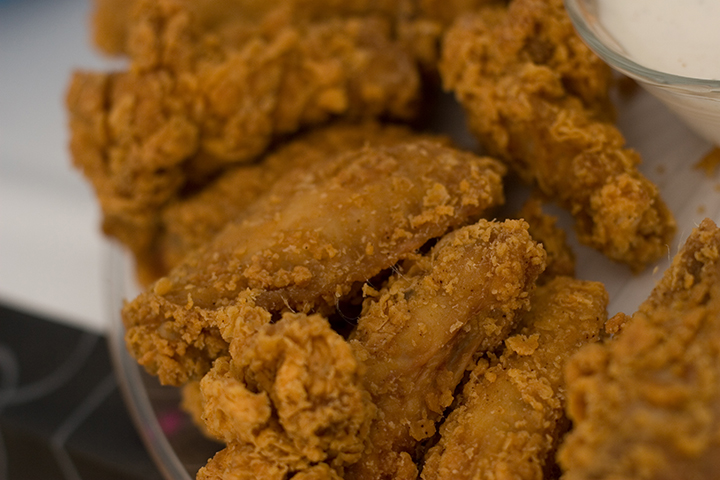 |
|
| Issue #41 • September/October, 1996 |
The southern region of the United States is almost as big as Western Europe, and despite the stereotype that non-Southerners havethat there is only one Southwhen someone says, “I am Southern,” the South contains almost as many subcultures as Europe has countries. This cultural diversity shows especially in Southern cooking. A close look at the culinary practices in this region will reveal the influence of German, Dutch, Spanish, French, Scottish, Irish, Native American, Asian, English, and African cultures. The result has been the rise of three broad and distinctive Southern cuisines: Classic Southern, which is a blend of Anglo Saxon and African roots; Southwestern, with its Spanish influenced ranch style cooking; and Creole/Cajun, a mixture of French Canadian, Native American, and African cuisines.

Thomas Jefferson |
English and African roots
Southern cookingin fact, all “American” cookingstarted nearly 400 years ago when a small group of weather-beaten, malnourished refugees landed on the eastern shores of North America. They’d left their homes, most of their relatives, and almost all their possessions in England and set sail for a new homeland where they sought religious freedom. In a very short time they established successful colonies at Plymouth in Massachusetts and at Jamestown in Virginia.
In spite of the dramatic climactic differences between the two colonies, the British women in both colonies set up their kitchens to accommodate the cooking style they had learned at home. But because winters in the Plymouth colony were cold and long, the settlers continued to rely mainly on the simple fortifying foods that were central to their Old World Puritan cooking style. Basic elements of this style survive today in New England Yankee cooking, e.g., when brine-cured meats and hearty leaf and root vegetables are combined to make boiled dinners.
Meanwhile, the milder climate experienced in the Virginia colony made life generally easier. And, though meals were also prepared along traditional lines, they were done so with a more relaxed attitude, meaning that in Jamestown the colonists made use of the more plentiful foods available there including a larger variety of vegetables and more herbs and spices. But even with this relaxed attitude toward traditional culinary practice, the food prepared in both was essentially the same.

Beet, dandelion, collards |
There is a myth that early English cooking and, therefore, the cooking style the colonists brought with them, was plain, simple and unimaginative. The truth is that from the beginning of 17th century to the early part of the 18th century there was a Renaissance in English cooking. English cookbooks from that time show evidence that this was a cuisine rich with a variety of herbs and spices in which foods were crafted by techniques that contributed subtleties of flavor and texture.
At the center of all of this was the ancient art of open hearth cooking. This is the most dangerous and back breaking way of preparing food that I can think of, but it imparts a flavor and texture to food that is impossible to duplicate by any other cooking method. Cooking on an open hearth requires the use of very specialized tools and utensils. Adjustable spits used for roasting gave the cook complete control over the roasting process. An array of cranes and pulleys made it possible to move pots closer or farther from the heat. There were Dutch ovens, with long legs and tight-fitting deep-rimmed lids which were buried in the hot coals to allow the contents to cook while the coals slowly cooled, thus creating stews, soups, and other wonderful dishes that exuded flavors and aromas that are all but unknown today.
Using these and other special utensils like long legged chaffing dishes, iron forks and tongues, salamanders for browning, gridirons for frying and grilling, long handled waffle and wafer irons, and clay brick baking ovens all required a sense of timing and a mastery of this cooking technique that is nearly a lost art. By the time you read this column, I will be participating in a special workshop called “Mastering The Art of Open Hearth Cooking.” I will share that experience with you in a future column.

Cabbage, chard |
Southern cooking blossoms
More important to Southern cooking, however, was an event, scarcely noticed at the time, that took place at Jamestown. In 1619 a Dutch ship anchored off the coast and offered the colonists a handful of slaves transported from Western Africa. Thus began the slave trade in North America and for the next two centuries African slaves were put to work supporting all aspects of the South’s agrarian economy. This included all of the food production responsibilities in many Southern kitchens.
Like their English sisters, the African women brought their native cooking techniques with them, and, once in the English kitchens, they demonstrated a natural flair for blending the ingredients they found there with other ingredients they were already familiar with, but which were new to the English palate. The resultant earthy foods, served in elegant style, have made Southern cooking legendary and it has survived political and social upheaval, wars, industrialization, and attempts by the commercial and fast food industry to bastardize it.
It was during the first half of the 19th century that Southern cooking really blossomed. All elements of the formula came together and were supported by the South’s rich economy. The tables of the upper and middle class households displayed some of the finest foods that could be found in this country.

Mustard, turnip |
Several critical events, however, would dramatically change the South and bring this era to an abrupt halt. When the War Between the States and the Emancipation Proclamation ended slavery, the legacy of African cooks running Southern kitchens came to an end. African cooks lost the Anglo Saxon influence and the Anglo Saxon households lost the creative ingenuity of the African cook. Poverty settled on the South, forcing most households to adopt simple diets of field peas, wild and cultivated greens, sweet potatoes, and a variety of dried corn products, supplemented by inexpensive pork products. A whole generation of Southern women left their kitchens and went into the work force, leaving little time for anything but essential cooking. Still, as meager as the food was, over the years even this food fare has been refined in Southern kitchens to the level of signature cuisine that any Southerner can be proud of.
Another factor in the nineteenth century that affected the cooking was the mass production of cast iron ranges that were sold at prices that most households could afford. This revolution in kitchen technology changed all American cooking because it signaled the end of open hearth cooking. But the inexpensive and convenient cast iron range could not produce the same results as spit roasting of meats before a hot fire and crusty breads like those baked in wood fired clay brick ovens.
Then the packaged food industry started to market off-the-shelf canned foods as an easy, but low quality alternative to the traditional labor-intensive methods of home preserving. The age of synthetic cheese, ham made with gluten, and imitation bacon had begun. American food was on its way to gastronomic disaster. It is a loss from which it has never fully recovered. Fortunately, in the South, tradition has never been considered an anecdote; and the legend of Classic Southern food has been kept alive throughout the region. And wherever Southerners have migrated, they have brought their cooking with them. On top of this, the culinary works of great 17th and 18th century authors have recently been revitalized to celebrate the past glories of traditional Southern cooking.

Kale, spinach |
The first American epicure
The first great American epicure of note was from the South. He was Thomas Jefferson, to some, the greatest American President. He not only served as President, he was a governor of Virginia, Secretary of State under Washington, and an American minister to France. But his first loves were farming and overseeing all of the culinary operations at Monticello. He himself designed Monticello along with its kitchen, and he never lost an opportunity to play host. At times he entertained as many as 50 guests in his custom built dining room. But because of his fascination with French foods and wines, he was accused by other native Virginians of “rejecting his native victuals.” It was an unfair accusation because Jefferson also relished such Southern delicacies as corn, dry cured Virginia ham, Jerusalem artichokes, scalloped tomatoes, peas, and rice. He grew 30 different varieties of peas at Monticello and risked becoming a criminal on death row because he smuggled seed rice from Italy into the United States for planting in his gardensa capital offense at the time that was punishable by hanging. Every year Jefferson’s April 13th birthday is celebrated with a lavish dinner party at his mansion. Of course classic Southern food is always a part of the menu.
To tell the story of Southern food would require an epic of several volumes. There are no boundaries where one can say Southern cooking starts and ends, and its ingredients are as varied as the mixture of different cultures that call the South home. There is no way I can do justice to it with the space I’m allowed in this column. But with what I do have, I will share with you some recipes that have been passed from my grandmother to my mother, and now they belong to me. There is nothing highfalutin (as my grandmother would say) about these foods. In fact, there is a certain grace in their simplicity and an elegance in the natural unmasked flavors that Southern fair offers all who appreciate good food.
Fried chicken
It would be blasphemy to discuss Southern food without giving some attention to fried chicken. The recipes and cooking methods for fried chicken are endless. Put a bunch of Southern cooks in the same room and they’ll disagree on everything from the ingredients to the actual cooking method. Some will insist that disjointed chicken, salt, pepper, flour, and fat are all that are necessary to make honest fried chicken. Others will make the same claim after adding to the formula various combinations of eggs, buttermilk, sweet milk, corn meal, bread crumbs, cracker crumbs, baking powder, and almost every variety of herb and spice known to man.
Some insist on frying in deep fat, others say shallow fat. They can’t even agree on the type of fat. You’ll hear lard, corn oil, and peanut oil each considered “best” by different cooks. So, if fried chicken is a must for you, I suggest that you consider you own taste and select the recipe and production method that you think comes closest to what you like.
Beware of recipes that tout themselves as “authentic Southern fried chicken” because there isn’t any single such thing. But, if you want to try a chicken recipe that is as Southern as you can get, without going through the mind boggling variations of frying, my grandmother’s Benne (pronounced ‘ben ay) Bake recipe is just the answer. Serve it hot for dinner with or without gravy, or chill it and plan a picnic.
|
||||||
Stewed Winter Sallet
Sallet (pronounce the “t”) is an old English word for greens. Turnip greens, mustard greens, dandelion greens, Swiss chard, collards, beet greens, and spinach are some of the most popular greens that grow in profusion in the South. Today they are one of the mainstays of Southern cooking, but there was a time when greens were considered unattractive food at all but the poorest dinner tables. Over the years the ingenuity of those who did the cooking in poor households transformed this humble food into a distinctive cuisine by mixing and matching with other basic foods like corn, rice, beans, and inexpensive cuts of pork.
The following recipe, stewed winter sallet, has been served by my family at dinner on New Year’s Day for as long as I can remember.
|
||||||
Pepper Sherry
This is a table condiment used in the deep south to add extra zing to everything from soups to vegetables. I carry a small bottle with me when I go to food shows to help me through a day of tedious tasting. It will also enhance the taste of any cooked greens without masking the flavor. It takes only a few minutes to make and will last in the refrigerator forever. If you want to put some in a small bottle to bring to your favorite restaurant, it will live without refrigeration.
|
||||
Hoppin John
This old Lowcountry rice and bean dish has a fascinating history that goes back to the late 1600s when Dr. Henry Woodward planted the first crop of Madagascar rice near Charleston, S.C. By the 1800s, Carolinians were using rice for currency and named their rice “Carolina Gold”.
Slave cooks from West Africa slowly introduced this dish to South Carolina as they were allowed to introduce their cookery into planters’ kitchens. Today Carolinians eat this dish on New Year’s Day to bring good luck in the coming year. If you’re interested in reading more about Hoppin’ John history, buy a copy of The Carolina Rice Kitchen by Karen Hess. But first try this recipe to get a taste of a food that is as classic Southern as fried green tomatoes or baked yams.
|
||||||
That’s it for this issue, but remember, when they say, “The South will rise again,” it’s going to be because their cooks are taking over.














